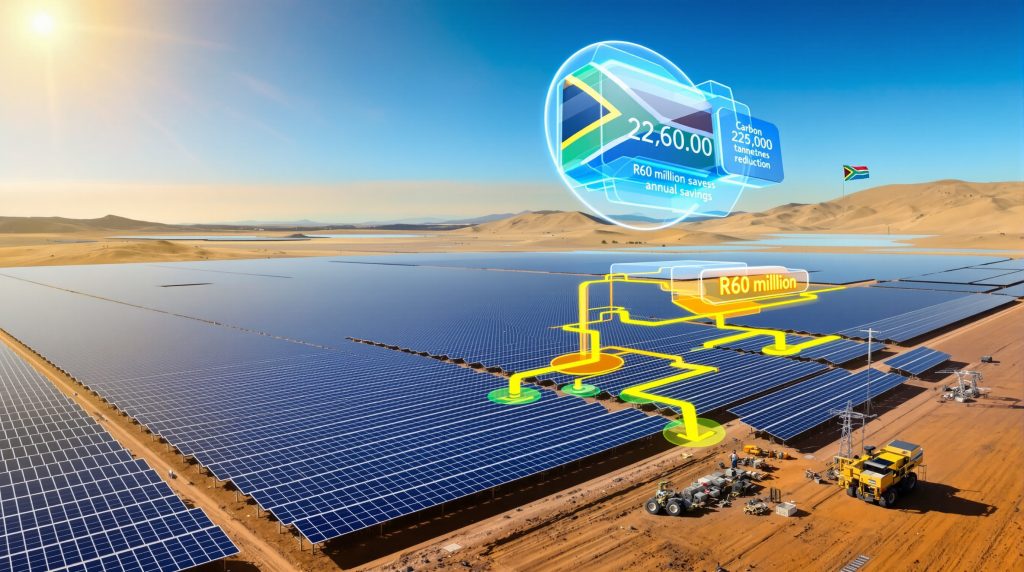Sibanye-Stillwater Springbok Solar Plant: Pioneering Renewable Energy in Mining
In South Africa's Free State province, a significant milestone in mining's transition toward renewable energy has emerged with the 150MW Springbok solar photovoltaic plant. This facility, which reached commercial operation in October 2025, demonstrates how major mining operations can adapt to energy challenges while pursuing ambitious energy transition strategies. Furthermore, it exemplifies the mining sector's growing commitment to environmental responsibility.
Project Overview and Specifications
The Springbok solar plant represents a cornerstone project in Sibanye-Stillwater's renewable energy strategy. Developed and financed by SOLA Group, an independent power producer, the plant operates under a wheeling agreement structure that allows the electricity to flow through Eskom's grid to the mining company's operations.
Key specifications include:
- Total capacity: 150MW alternating current (MWac)
- Location: Free State province, South Africa
- Commercial operation date: October 2025
- Power allocation: 75MW dedicated to Sibanye-Stillwater operations
- Contract structure: 10-year power purchase agreement
The facility's strategic location in the Free State provides optimal solar irradiation levels averaging 5.5-6.0 kWh/m²/day, making it an ideal site for solar energy production. According to the Global Solar Atlas developed by the World Bank Group, this region offers some of South Africa's most favorable conditions for solar power generation.
Financial and Operational Benefits
The Springbok solar plant delivers substantial financial advantages to Sibanye-Stillwater's operations, providing both immediate cost savings and long-term energy security. Notable benefits include:
- Annual cost savings: Over R60 million at current Eskom electricity rates
- Energy supply contribution: Approximately 4% of Sibanye-Stillwater's local energy needs
- Carbon emissions reduction: Approximately 229,000 tonnes of CO₂ equivalent annually
- Carbon tax implications: At South Africa's current carbon tax rate of R159/tonne, this represents approximately R36.4 million in potential carbon tax liability avoided
- Emission reduction percentage: Represents about 3.6% of the group's Scope 1 and 2 emissions
According to the National Energy Regulator of South Africa (NERSA), Eskom's average tariff increase for 2024/25 was 12.74%, highlighting the financial prudence of securing long-term, predictable energy costs through renewable power purchase agreements.
What Makes the Springbok Solar Plant a Strategic Investment?
Energy Security in South Africa's Mining Sector
The Springbok solar project addresses critical energy security challenges facing South Africa's mining industry. The South African mining sector is one of the most energy-intensive globally, consuming approximately 15% of the country's total electricity generation according to the Minerals Council South Africa's "Facts and Figures 2023" report.
This dependency makes mining operations particularly vulnerable to the country's ongoing power crisis. According to the Council for Scientific and Industrial Research (CSIR) Energy Centre, South Africa experienced over 6,000 hours of load shedding in 2023—the worst year on record for power outages. For mining companies, these disruptions translate directly to production losses and increased operational risks.
The Minerals Council South Africa estimated that load shedding cost the mining industry approximately R25 billion in lost revenue during 2023 alone, demonstrating the compelling business case for alternative energy sources.
Wheeling Agreement Structure
The Springbok facility operates under a wheeling agreement—an innovative structure that allows electricity generated at the solar plant to be transmitted through Eskom's grid to Sibanye-Stillwater's operations. This model enables:
- Geographical flexibility: Power generation can occur in optimal solar locations regardless of proximity to mining operations
- Grid integration: Utilizes existing transmission infrastructure without requiring dedicated power lines
- Multi-buyer potential: The facility's remaining 75MW capacity can serve other commercial customers
- Cost efficiency: Avoids the substantial capital expenditure required for direct transmission infrastructure
South Africa's electricity regulation framework enables these arrangements under the Electricity Regulation Act (No. 4 of 2006), with NERSA's wheeling framework (2022 revision) providing the technical and commercial guidelines for implementation.
Competitive Advantages
Beyond immediate cost savings, the Springbok solar plant delivers several strategic advantages:
- Predictable energy costs: Long-term PPA provides cost stability compared to volatile Eskom tariffs, which have risen at compound annual rates exceeding 10% over the past decade
- Operational resilience: Reduced vulnerability to load shedding and grid instability
- Sustainability credentials: Enhanced ESG profile attracts sustainability-focused investors
- Regulatory compliance: Alignment with South Africa's carbon tax regime and emissions regulations
How Does Springbok Fit Into Sibanye-Stillwater's Renewable Energy Portfolio?
Current Renewable Energy Projects
The Springbok solar plant is part of a comprehensive 407MW renewable energy portfolio that Sibanye-Stillwater has contracted. This strategic approach combines multiple technologies and project structures to optimize energy security and cost benefits.
| Project Name | Technology | Capacity | Status | Annual CO₂ Reduction |
|---|---|---|---|---|
| Springbok | Solar PV | 150MW | Operational (Oct 2025) | 229,000 tonnes |
| Castle | Wind | 89MW | Operational (Apr 2025) | Not specified |
| Other contracted projects | Various | 168MW | In development | Not specified |
The portfolio's diversification across solar and wind technologies demonstrates sophisticated energy planning, as these resources have complementary generation profiles. Solar generation peaks during daylight hours, while wind resources in South Africa often strengthen during evening and overnight periods, potentially providing more consistent renewable supply.
Strategic Energy Transition Roadmap
Sibanye-Stillwater's renewable energy initiatives form part of a broader strategic plan with multiple objectives:
- Carbon neutrality target: Achieve carbon neutrality by 2040, as confirmed by CEO Richard Stewart
- Energy independence: Reduce reliance on Eskom's constrained grid
- Cost management: Mitigate against rising electricity tariffs
- Operational stability: Ensure consistent power supply for mining operations
- Environmental compliance: Address increasing regulatory pressure on carbon emissions
Implementation Timeline
The company has established a clear pathway for renewable energy integration:
- 2025: 164MW of renewable capacity brought online (Springbok solar and Castle wind)
- Coming years: Additional 243MW to be implemented from the contracted 407MW portfolio
- 2040: Target date for achieving carbon neutrality across operations
Based on the 3.6% emissions reduction from the 150MW Springbok facility, the complete 407MW portfolio could potentially reduce the company's carbon footprint by approximately 10-12% once fully operational. This indicates that additional investments beyond the current contracted projects will be necessary to achieve the 2040 carbon neutrality goal.
What Are the Environmental and Community Impacts?
Carbon Footprint Reduction
The Sibanye-Stillwater Springbok solar plant makes a substantial contribution to environmental objectives:
- Annual emissions avoidance: 229,000 tonnes of CO₂ equivalent
- Percentage of total emissions: Approximately 3.6% of the group's Scope 1 and 2 emissions
- Carbon tax implications: Reduced liability under South Africa's carbon tax regime
South Africa's electricity grid has one of the highest emission factors globally at approximately 1.09 kg CO₂e per kWh, according to the Department of Forestry, Fisheries and the Environment. This makes renewable energy investments particularly effective for carbon reduction in the South African context.
Broader Environmental Benefits
Beyond carbon reduction, the solar facility delivers several additional environmental advantages:
- Water conservation: Solar PV requires minimal water (0.02-0.1 gallons per kWh) compared to coal-fired alternatives (0.6-1.8 gallons per kWh), according to IRENA's "Water Use in Renewable Energy" 2022 report
- Air quality improvement: Zero particulate emissions compared to coal-fired alternatives
- Land use efficiency: The 150MW facility requires approximately 300-600 hectares based on industry standards of 2-4 hectares per MW
Community and Economic Impact
While specific community benefits of the Springbok project would require verification from official project documentation, renewable energy projects in South Africa typically deliver:
- Job creation: Based on IRENA's "Renewable Energy and Jobs" report (2023), a 150MW solar facility typically creates 225-375 construction jobs at peak and 45-75 permanent positions
- Skills development: Training in renewable energy technologies creates transferable skills
- Local economic stimulus: Procurement from regional suppliers supports business growth
- Energy infrastructure improvement: Enhanced grid stability in project areas
South Africa's renewable energy projects typically include commitments to local economic development, skills development, and enterprise development as part of their licensing requirements, though specific details for the Springbok project would need to be obtained from project documentation.
How Does This Project Compare to Other Mining Sector Renewable Initiatives?
Industry Context and Benchmarking
The mining sector globally is increasingly adopting renewable energy solutions to address both cost pressures and sustainability targets. According to the Minerals Council South Africa's annual report, mining companies in South Africa had committed to approximately 3,000MW of renewable energy capacity by the end of 2023.
Notable projects in the sector include:
- Anglo American's Renewable Energy Programme: Anglo American announced plans to develop 3-5GW of renewable energy capacity across its global operations by 2030
- Gold Fields' South Deep Solar Plant: Gold Fields operates a 40MW solar plant at its South Deep mine, which became operational in 2020
- Harmony Gold's Renewable Projects: Harmony Gold announced plans for 30MW of solar capacity at its Kusasalethu mine in 2022
Competitive Positioning
At 150MW total capacity, the Springbok solar plant represents one of the larger mining-linked solar projects in Africa, positioning Sibanye-Stillwater as an industry leader in renewable energy adoption. This scale delivers several competitive advantages:
- First-mover advantage: Early adoption of large-scale renewables positions Sibanye-Stillwater favorably as carbon regulations tighten
- Cost leadership: Energy cost savings improve competitive position in global markets
- Investor appeal: Enhanced ESG credentials potentially attract sustainability-focused investors
The wheeling model employed by the Springbok project represents an innovative approach that other mining companies may emulate, as it combines optimal siting of generation assets with flexible delivery to operational sites.
What Does This Mean for South Africa's Energy Transition?
National Energy Context
South Africa's electricity system faces significant challenges, with coal-fired generation accounting for approximately 80% of the country's 46,000MW installed capacity, according to Eskom's 2024 Integrated Report. This dependence on coal has created both environmental and reliability challenges.
The Springbok project contributes to South Africa's broader energy transition in several ways:
- Grid diversification: Adds renewable capacity to a predominantly coal-powered grid
- Private sector leadership: Demonstrates how businesses can advance energy solutions independently
- Regulatory precedent: Establishes successful implementation of wheeling agreements
- Investment signal: Shows viability of renewable investments in the South African context
Policy Alignment
The project aligns with several key national energy and environmental policies:
- Integrated Resource Plan: Supports South Africa's goals for increased renewable energy capacity, which according to the IRP 2019 includes targets for 14,400MW of wind power and 6,000MW of solar PV by 2030
- Carbon reduction commitments: Contributes to national emissions reduction targets
- Just Energy Transition Partnership: Supports the objectives of South Africa's $8.5 billion Just Energy Transition Partnership with international partners
Private sector investments like the Springbok plant are becoming increasingly important contributors to South Africa's energy transition. Schedule 2 of the Electricity Regulation Act was amended in 2021 to increase the licensing threshold for private generation from 1MW to 100MW, enabling projects like Springbok to proceed without full electricity generation licenses.
What Challenges and Opportunities Lie Ahead?
Implementation Challenges
While the Springbok project represents a success, several challenges typically face mining companies implementing renewable energy:
- Grid integration: According to industry reports, grid connection applications in South Africa can take 18-36 months to process through Eskom and NERSA approval processes
- Regulatory complexity: Navigating evolving energy regulations and permitting processes
- Technical expertise: Developing internal capabilities to manage renewable energy assets
- Capital allocation: Balancing renewable investments against core mining operations
The wheeling framework in South Africa has progressively matured since 2018, with the current framework (2022 revision) providing greater clarity on costs, access, and technical requirements. This regulatory maturation has enabled commercial-scale projects like Springbok.
Future Opportunities
Looking forward, several opportunities may emerge for Sibanye-Stillwater and the broader mining sector:
- Battery storage integration: Lithium-ion battery storage costs have declined to approximately $250-350/kWh for utility-scale installations as of 2024, down from $600-800/kWh in 2018
- Expansion potential: Scaling up renewable capacity as technology costs continue to decline
- Hydrogen applications: Exploring green hydrogen production from excess renewable generation
- Community energy sharing: Extending benefits to surrounding communities through shared infrastructure
As South Africa's grid emission factor is projected to decline from the current ~1.09 kg CO₂e/kWh to approximately 0.65 kg CO₂e/kWh by 2030 (according to CSIR Energy Centre modeling), the carbon reduction impact of renewable projects will gradually decrease, making early implementation more valuable for carbon goals.
What Are the Key Takeaways from Sibanye-Stillwater's Renewable Energy Strategy?
Strategic Insights
Sibanye-Stillwater's approach to renewable energy offers several lessons for the mining sector:
- Diversified technology approach: Combining solar and wind technologies optimizes generation profiles and improves reliability
- Third-party financing: Leveraging PPAs to avoid capital expenditure while securing price benefits
- Incremental implementation: Phased approach to renewable integration, building on successful projects
- Long-term vision: Clear carbon neutrality target guiding investment decisions
- Operational integration: Aligning energy strategy with core mining operations
The company's strategy demonstrates how mining operations can pursue multiple objectives simultaneously: enhancing energy security, reducing costs, and advancing sustainability transformation in the resource sector. Additionally, their approach reflects broader industry evolution trends toward decarbonization.
Business Model Innovation
The Springbok project demonstrates how mining companies can innovate in their approach to energy:
- Multi-buyer structures: Creating shared infrastructure that serves multiple customers
- Grid partnership: Working with national utilities rather than bypassing them
- Risk management: Using renewable energy as a hedge against price volatility and supply constraints
This model potentially offers a blueprint for other mining companies seeking to enhance their energy security while advancing green metals leadership and mine reclamation innovation.
FAQ: Sibanye-Stillwater Springbok Solar Plant
What is the capacity of the Springbok solar plant?
The Springbok solar plant has a total capacity of 150MW, with 75MW dedicated to Sibanye-Stillwater's operations under a 10-year power purchase agreement.
How much will the solar plant save Sibanye-Stillwater annually?
The company expects annual savings of over R60 million at current Eskom electricity rates.
What percentage of Sibanye-Stillwater's energy needs does the solar plant meet?
The Springbok solar plant meets approximately 4% of Sibanye-Stillwater's local energy requirements in South Africa.
How does the solar plant contribute to carbon reduction goals?
The facility reduces approximately 229,000 tonnes of carbon dioxide equivalent emissions annually, representing about 3.6% of the group's Scope 1 and 2 emissions.
What is Sibanye-Stillwater's overall renewable energy target?
The company has contracted a total of 407MW of renewable energy projects as part of its journey toward achieving carbon neutrality by 2040.
Who developed and financed the Springbok solar project?
The project was developed and financed by SOLA Group, an independent power producer, with Sibanye-Stillwater committing to purchase power through a long-term agreement.
What other renewable energy projects has Sibanye-Stillwater implemented?
In addition to the Springbok solar plant, Sibanye-Stillwater has brought the 89MW Castle wind farm online in 2025, with additional renewable projects in development to complete its 407MW portfolio.
Looking to Invest in the Next Major Mineral Discovery?
Stay ahead of the market with Discovery Alert's proprietary Discovery IQ model, which instantly alerts investors to significant ASX mineral discoveries, turning complex mineral data into actionable insights. Understand why historic discoveries can generate substantial returns by visiting Discovery Alert's dedicated discoveries page and begin your 30-day free trial today.




